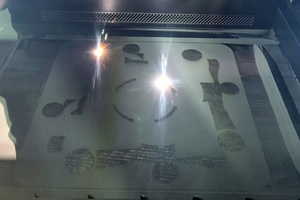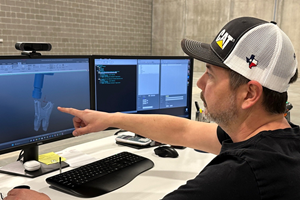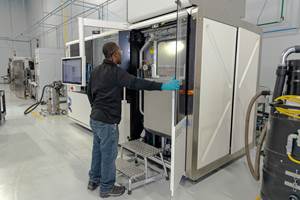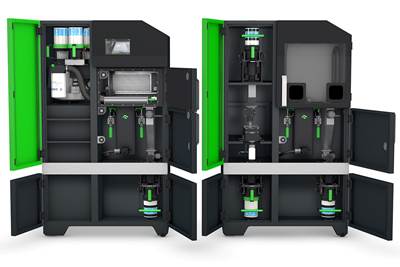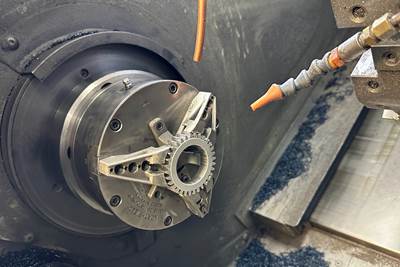Video: 3D Printing Consolidates Assembly, Reduces Cost for Bar Feeder Component
At IMTS 2024, 3D printer supplier One Click Metal highlighted how its low-cost metal printer can help improve machining, showcasing components for Index bar feeders that were redesigned for additive.
Share





Additive manufacturing (AM) promises lightweighting, assembly consolidation and other advantages to end-use parts. While the technology is sometimes thought to be in competition with machining, subtractive processes are also benefiting from AM, with 3D printed parts now making their way into CNC mills, turning centers and bar feeders, as seen in this video.
Filmed at the 2024 edition of IMTS – The International Manufacturing Technology Show, the video highlights One Click Metal’s BoldSeries platform, a laser powder bed fusion (LPBF) metal 3D printer engineered for safety and ease of use. The compact printer and its associated depowdering/sieving station use powder cartridges to move and store the material, so that the user rarely if ever needs to handle loose powder. Together, the two machines cost about $200,000, making this platform an attractive choice for universities, R&D labs, product development users and end-use part producers, including small and medium businesses with no prior experience in metal 3D printing.
One Click Metal originated as a spinout from laser technology specialist Trumpf. Turning center supplier Index is now a majority investor, and the video above was shot in the Index booth at IMTS. Index is finding applications for LPBF among the components of its machines; one example shown is a slider trolley used in bar feeders. Redesigning the assembled component for 3D printing resulted in a design that can be manufactured at 77% lower cost, with reduced risk of part failure.
Related Links
- One Click Metal U.S. partnership with distributor Select Additive
- Another example of 3D printing assisting with a turning application
- More on additive manufacturing at IMTS 2024
Transcript
Laser powder bed fusion. You know it. You love it. But it is not always the most user friendly process. This company wants to change that.
I'm Stephanie Hendrixson with Additive Manufacturing Media here at IMTS 2024, in the Index booth where One Click Metal is exhibiting. One Click Metal is a spin out from Trumpf that is trying to make laser powder bed fusion more accessible and easy to apply for universities, labs and small to medium manufacturers that may not have experience with this process.
They created this platform, which consists of two different machines, one which has the printer the other that has the sieving and powdering capability. The whole system is engineered for modularity, with an aim toward keeping the operator away from the powder, which can be a hazard if it's breathed in or if it gets out into the larger facility.
So the powder is installed into the machine through these cartridges. The machine can be equipped with up to five at the same time for continuous production. Or if you need to refill in the middle of a build. The material is passed into the build volume, with a system that's designed to limit the contamination of the actual build space. Excess powder is swept off of the bed and collected through this funnel and ends up in this canister down here.
Inside the machine, anywhere that you see these green handles, these are the only places that the operator really needs to interact with or do anything.
Otherwise, the powder and the parts and the entire build are contained within here.
Once the build is completed, the entire build module comes out and it can be moved via trolley over to the depowdering station. The parts get depowdered, the excess material is collected and sieved, and then again dropped into a canister that would be down at the bottom of this system.
So this is laser powder bed fusion in a very compact footprint. You just need these two machines to get started. And the system can be applied in a lab setting, in a school setting, or at a manufacturer that may not have a whole lot of space.
One Click Metal offers a couple of different build modules. There is sort of the standard build module. There is a taller one that's coming. And then they also have the lab module, which requires a much smaller amount of metal powder to get started, which can be useful if you're working with an experimental alloy or a precious metal, something that might be expensive and you don't want to use a lot of it.
This platform can print with stainless steel and aluminum, titanium and more. Applications include prototyping, product development and short run manufacturing, including some components for conventional manufacturing.
So we're here in the Index booth, Index is a manufacturer of CNC turning centers, but it is also a majority investor in One Click Metal. They are exploring using this technology for components of some of their systems.
Here's one of the components that they're looking at. This is a slider trolley. It is part of a bar feeder, and part of the mechanism that feeds barstock into the chamber of a multispindle turning center.
Currently this part is manufactured in two pieces. It's a sheet metal component and a turned piece that get welded together. But that manufacturing process is a little bit complicated because of the welding step. And Index has seen some wear and some failure along that welding seam. They say that they need about 520 of these components per year, and it costs about 120 euro to manufacture each one today.
So One Click Metal and Index work to redesign this part for laser powder bed fusion. They combined the two pieces into one design. They optimized to reduce some of the weight. And they came up with this component which is now just one piece, reducing the scrap, reducing the weight of the component, and also reducing a lot of the assembly work. It also brought the price of these trolley sliders down by 62%. These parts can be printed 42 at a time in a build on the One Click Metal machine, which takes about 50 hours, and it costs around 27 euro per part made that way.
This is still an application in development. There's still a ways to go, but it is a great indicator of how just very simple assembly consolidation going from two parts down to just one, can have major impacts on the supply chain, on the workflow and on the cost of a component.
So for more information about laser powder bed fusion, about additive manufacturing helping conventional manufacturing, see the links in the video description. And if you'd like to learn more about additive technology and applications, follow Additive Manufacturing Media wherever you're watching.
Related Content
Digital Thread Enables First-Time-Right 3D Printing
Connecting all stages of manufacturing, from design to postprocessing, helps break down barriers to industrializing additive manufacturing.
Read MoreDigital Transparency in Machining Key to Multi-Site Additive Manufacturing
Cumberland Additive’s CNC programmer in Pennsylvania spends most of his time writing programs for machine tools in Texas.
Read MoreMachine Tool Drawbar Made With Additive Manufacturing Saves DMG MORI 90% Lead Time and 67% CO2 Emission
A new production process for the multimetal drawbar replaces an outsourced plating step with directed energy deposition, performing this DED along with roughing, finishing and grinding on a single machine.
Read MoreThe Benefits of Vertically Integrating Metal 3D Printing and Machining
Having 3D printing and machining within one organization enables Addman’s engineers to collaborate and consolidate so it can quickly make successful metal 3D printed parts.
Read MoreRead Next
New Equipment, Additive Manufacturing for Casting Replacement and AM's Next Phase at IMTS 2024: AM Radio #54
Additive manufacturing’s presence at IMTS – The International Manufacturing Technology Show revealed trends in technology as well as how 3D printing is being applied today and where it will be tomorrow. Peter Zelinski and I share observations from the show on this episode of AM Radio.
Read MoreOne Click Metal Partners With Select Additive to Expand US Presence
Together, the companies aim to deliver cutting-edge solutions, expert guidance and support to businesses seeking to harness the power of metal additive manufacturing.
Read MoreChuck Jaws Achieve 77% Weight Reduction Through 3D Printing
Alpha Precision Group (APG) has developed an innovative workholding design for faster spindle speeds through sinter-based additive manufacturing.
Read More
.jpg;width=70;height=70;mode=crop)






















